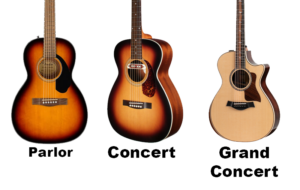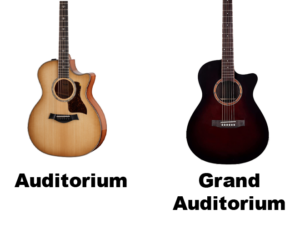Uncategorized
Unveiling the Soulful Harmony: Exploring the Enigmatic F9 Chord
In the realm of music, there exists a chord that possesses a soulful and enigmatic quality – the F9 chord. Like a hidden treasure waiting to be unearthed, the F9 chord adds a touch of sophistication and intrigue to musical compositions. If you’re curious about delving into the enchanting world of the F9 chord and discovering its secrets, you’re about to embark on a harmonic journey that will elevate your musical prowess. In this article, we’ll dive into the realm of the F9 chord, unveil its unique characteristics, and guide you through the process of incorporating its lush tones into your playing. So, let’s pick up our instruments and embark on a melodic exploration of the captivating F9 chord.
The F9 Chord: A Harmonic Gem
The F9 chord is a jazz-infused harmony that adds depth and complexity to musical arrangements. It’s a versatile and expressive chord that can evoke a range of emotions, from nostalgia to contemplation.
Decoding the F9 Chord: Its Components
The F9 chord is composed of several essential elements:
1. Root Note (F): The root note forms the foundation of the chord and gives it its tonal center.
2. Major Third (A): The major third interval adds a sense of brightness and character to the chord.
3. Perfect Fifth (C): The perfect fifth interval contributes to the chord’s stability and harmonic structure.
4. Minor Seventh (Eb): The minor seventh interval introduces a touch of tension and provides a bluesy quality to the chord.
5. Dominant Ninth (G): The dominant ninth interval, often referred to as the “color tone,” gives the chord its distinct flavor and complexity.
The Expressive Palette of the F9 Chord
The F9 chord offers a range of expressive possibilities:
1. Rich Harmonic Texture: The combination of intervals in the F9 chord creates a rich and textured sound that can stand out in both solo and ensemble settings.
2. Bluesy Edge: The presence of the minor seventh interval infuses the F9 chord with a bluesy and soulful quality, making it a favorite in jazz, blues, and funk genres.
3. Chord Progressions: The F9 chord is often used in chord progressions to add movement and color to a sequence of chords.
Mastering the F9 Chord: A Step-by-Step Guide
To master the F9 chord and incorporate its harmonic allure into your playing, follow these steps:
1. Finger Placement: Begin by placing your fingers on the appropriate frets and strings to form the F9 chord. Ensure that each note rings out clearly and without any unwanted buzzing.
2. Strumming and Picking: Practice strumming and picking the F9 chord to familiarize yourself with its sound and feel.
3. Chord Transitions: Practice transitioning between the F9 chord and other chords in your repertoire. This will enhance your ability to incorporate the F9 chord into different musical contexts.
4. Experimentation: Explore different strumming patterns, arpeggios, and fingerpicking techniques to showcase the F9 chord’s versatility.
Adding Depth with F9 Variations
Once you’re comfortable with the basic F9 chord, consider exploring variations to add depth and flavor to your playing:
1. F9sus4: Try substituting the dominant ninth (G) with the suspended fourth (Bb). This variation adds a unique twist to the chord’s sonic palette.
2. F9#11: Experiment with adding the sharp eleventh (C#) to the F9 chord for a more sophisticated and jazzy sound.
Crafting Musical Stories with the F9 Chord
Congratulations, you’ve embarked on a harmonic adventure to explore the captivating F9 chord! By understanding its components, mastering its finger placement, and experimenting with variations, you’ve gained insights that will elevate your musical expression and allow you to craft melodies that resonate deeply.
As you continue your exploration of the F9 chord, remember that you’re adding an enigmatic and soulful color to your musical palette. With each strum, you’re weaving sonic stories that transport listeners to emotional landscapes, evoke feelings, and ignite the imagination. So, embrace the F9 chord’s harmonic allure, and let your fingers dance across the fretboard, painting melodic pictures that captivate hearts and minds. Happy strumming and happy harmonizing!
Uncategorized
Acoustic Guitar Sizes: Finding Your Perfect Fit
Have you ever wondered how the size of an acoustic guitar affects its sound? From the intimate, focused tones of a parlor guitar to the deep, resonant sound of a jumbo, the size and shape of an acoustic guitar can have a profound impact on its sonic characteristics.”
In this article, we’ll explore acoustic guitar sizes, their variations, and how to choose the perfect size that suits your needs.
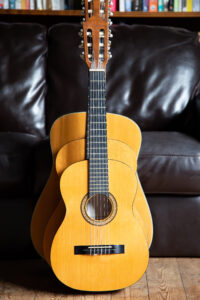 Understanding Acoustic Guitar Sizes: A Musical Puzzle
Understanding Acoustic Guitar Sizes: A Musical Puzzle
Acoustic guitar sizes refer to the dimensions and proportions of the guitar body, which significantly influence the instrument’s tonal characteristics, projection, and playability.
Just like pieces of a musical puzzle, different sizes create distinct voices that cater to various playing styles and preferences.
The Spectrum of Acoustic Guitar Sizes
Acoustic guitars come in several sizes, each with its unique qualities and attributes. Let’s explore some common acoustic guitar sizes and their defining features:
-
-
Parlor Guitar: The parlor guitar is petite and charming, making it an ideal companion for intimate settings.
The name comes from the rooms in which the guitar was typically played in the late 19th century.
Some famous musicians who have been known to use the parlor guitar are, Eric Clapton, Mark Orton, Ed Sheehan, and John Mayer
Its smaller size results in a focused and balanced sound, perfect for fingerpicking and folk music.
-
Concert Guitar: Slightly larger than the parlor guitar, the concert guitar offers enhanced projection and volume. It strikes a balance between portability and sound, making it versatile for various genres.
It is often used in classical music and flamenco music with its full sound.
-
Grand Concert Guitar: With a larger body than the concert guitar, the grand concert guitar boasts a fuller sound and improved tonal complexity.
A popular choice for those who have a smaller stature and require an instrument that’s built to a shorter scale. Great choice for traveling musicians who often play live performances.
It’s suitable for fingerstyle playing and intricate arrangements.
-
Auditorium Guitar: The auditorium guitar, also known as the orchestra model (OM), features a well-rounded sound with a pronounced midrange.
More shallower than the dreadnought and narrower in width than a concert guitar. An Auditorium guitar brings the body closer to the player, making it feel more intimate and comfortable for stage use.
Some famous musicians who play it include Ed Sheeran, John Mayer, and Eric Clapton.
-
Grand Auditorium Guitar: Expanding on the auditorium guitar’s design, the grand auditorium guitar offers a versatile sound profile with enhanced bass response and overall volume.
It is a versatile mid-sized guitar that is a good choice for those who want a single guitar to travel with. The tone is great for strumming and picking. It performs well on stage and in the studio.
It suits a wide range of musical genres.
-
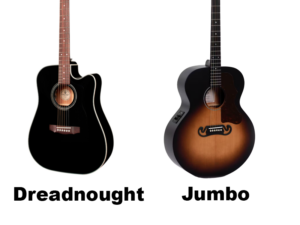 Dreadnought Guitar: The Dreadnought is a true icon, known for its bold and powerful sound. Its large body produces a strong bass response, making it ideal for strumming and vocal accompaniment.
Dreadnought Guitar: The Dreadnought is a true icon, known for its bold and powerful sound. Its large body produces a strong bass response, making it ideal for strumming and vocal accompaniment.This guitar is known for its powerful voice and lower-mid-rich tones that make it a favored choice for country artists. Although it is a popular choice for musicians of all genres.
Some famous musicians who play the dreadnought guitar include Hank Williams Jr, Elvis Presley, Keith Richards, Thom Yorke, and Kurt Cobain.
The original dreadnought guitars were made for the Oliver Ditson Company and featured mahogany backs and sides and spruce tops.
-
Jumbo Guitar: The jumbo guitar lives up to its name with a massive body that delivers robust volume and a deep bass presence.
This is the largest of the guitar family with a deeper body than the popular dreadnought. The body is wider and deeper than traditional acoustic guitars, which gives them a unique appearance.
Jumbo’s are well suited to rhythm guitarists in country and folk rock, and produce a deep rich sound favored by heavy strummers. Some famous musicians who play this guitar are Elvis Presley, George Harrison of the Beatles, Neil Young, Sheryl Crow, and Pete Townshend of The Who.
Choosing the Right Acoustic Guitar Size for You
Selecting the right acoustic guitar size involves considering factors such as playing style, comfort, and tonal preferences. Here are some steps to guide you on your quest:
-
Identify Your Playing Style: Determine whether you lean towards fingerpicking, strumming, or a mix of both. Different sizes excel in different playing styles, so choose one that complements your technique.
-
Consider Body Comfort: Hold and play guitars of various sizes to assess comfort. A guitar that fits well against your body ensures a pleasant playing experience, especially during extended sessions.
-
Evaluate Sound Preferences: Listen to the sound produced by different acoustic guitar sizes. Pay attention to tonal qualities, such as warmth, brightness, and projection, to find the one that resonates with your musical taste.
The Influence of Acoustic Guitar Sizes on Music
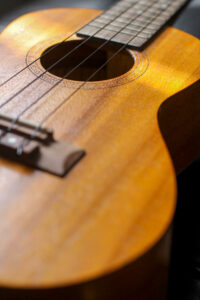 Acoustic guitar sizes and shapes can have a significant impact on the sound of the instrument.
Acoustic guitar sizes and shapes can have a significant impact on the sound of the instrument.The size of the guitar body type also relates to the volume of air within the instrument. Changes to the air capacity of the body will emphasize specific frequencies. A smaller body will have a more focused sound centered on higher frequencies, while a larger body will produce deeper low-end frequencies.
Body dimensions can provide some indication of the tone you might expect, but other factors exert a profound influence, too. Much depends on the tonewoods used to construct the body and the shape, size, and layout of the braces.
Finding Harmony in Acoustic Guitar Sizes
By delving into the nuances of size, sound, and playability, you’ve gained insights that will guide you toward the perfect fit for your musical aspirations.
As you continue your exploration, remember that each acoustic guitar size has its own unique voice and character. Embrace the joy of trying different sizes, celebrate the nuances of their sounds, and let your heart lead you to the one that resonates with your musical soul.
-
Uncategorized
Mastering the F Bar Chord: A Guide to Tackling the Mighty F Bar Chord
Hello, aspiring guitarists and music lovers! Are you ready to dive into the world of bar chords and conquer the formidable F bar chord? In this guide, we’ll unravel the mysteries of the F bar chord, learn how to play it with confidence, and discover how this versatile chord can enhance your playing. Whether you’re a beginner seeking to expand your chord repertoire or a guitarist eager to refine your skills, this article is your gateway to mastering the challenging yet rewarding “F bar chord.” So, grab your guitar, find a cozy spot, and let’s embark on a harmonious journey of musical exploration!
Demystifying the F Bar Chord: An Adventure in Guitar Mastery
Think of the F bar chord as a musical challenge that, once conquered, opens doors to a world of musical possibilities. Also known as the F major bar chord, this shape allows you to play the F major chord in various positions along the fretboard. Let’s embark on a journey to unlock the mechanics of playing the F bar chord and discover its potential to enrich your guitar-playing journey.
Mastering the F Bar Chord: A Step-by-Step Approach
To play the F bar chord, follow these simple steps:
1. Positioning: Place your index finger flat across all the strings at a specific fret. For the F bar chord, we’ll start with the 1st fret.
2. Bar with Index Finger: Press down firmly on all the strings with your index finger, creating a “bar” across the fret.
3. Finger Placement: Position your other fingers to form the shape of the F major chord. Your middle finger goes on the 2nd fret of the G string (the third thickest string), your ring finger on the 3rd fret of the A string (the fifth thickest string), and your pinky on the 3rd fret of the D string (the fourth thickest string).
4. Strumming: Focus on strumming the A, D, G, B, and high E strings (the thickest through first string) while avoiding the low E string (the sixth string).
5. Sound Check: Strum the strings individually to ensure each note rings out clearly. Adjust finger placement if needed for optimal resonance.
Overcoming F Bar Chord Challenges: Tips and Techniques
Mastering the F bar chord may require some patience and practice. Here are a few strategies to help you conquer this chord:
1. Build Finger Strength: Strengthen your index finger by practicing pressing down on the strings along the fretboard.
2. Use the Side of Your Finger: Press down on the strings with the bony side of your index finger, ensuring even pressure across the fret.
3. Finger Placement: Experiment with finger placement to find the angle that provides the best sound without muting any strings.
F Bar Chord Variations: Expanding Your Repertoire
Once you’ve mastered the basic F bar chord, you can explore various chord variations and positions:
1. Move It Up the Neck: Slide the F bar chord shape up the fretboard to play different major chords.
2. Minor Chords: Modify the F bar chord shape to play minor chords by altering the finger positions.
F Bar Chord in Action: Musical Inspiration
The F bar chord’s versatility makes it a valuable tool in your musical arsenal. Here are a few popular songs that feature the F bar chord:
1. “Wonderwall” by Oasis: The F bar chord adds a distinctive flavor to the intro of this iconic hit, capturing its melodic essence.
2. “Hey There Delilah” by Plain White T’s: This heartfelt ballad utilizes the F bar chord, contributing to its emotive and romantic vibe.
Tips for Mastery: Conquering the F Bar Chord
As you embark on your journey to master the F bar chord, keep these tips in mind:
1. Consistent Practice: Dedicate regular practice sessions to build muscle memory and familiarity with the F bar chord shape.
2. Patience and Persistence: Bar chords can be challenging, but with time and persistence, you’ll see steady improvement.
3. Smooth Transitions: Practice transitioning between the F bar chord and other chords to enhance your playing fluency.
Conclusion: Elevate Your Playing with the F Bar Chord
Congratulations, you’ve unlocked the powerful F bar chord and added a valuable tool to your guitar-playing repertoire! By mastering this chord, you’re opening doors to a world of musical expression and creativity. As you strum, experiment with variations, and play songs, you’ll discover the ability of the F bar chord to enrich your playing and add depth to your musical creations. Keep practicing, keep experimenting, and keep embracing the versatile F bar chord. It’s your key to unlocking a world of melodic exploration, where each note resonates with confidence and charm. So, pick up your guitar, embrace the challenge, and let the captivating F bar chord guide you toward a realm of melodies that captivate the senses and elevate the spirit, one beautifully barred note at a time!
Uncategorized
Exploring the Melodic Universe of Jazz Scales: Your Gateway to Musical Elegance
Hello, music enthusiasts and curious minds! Are you ready to embark on a harmonious journey that unveils the enchanting world of jazz scales? Today, we’re delving into the captivating realm of jazz scales – a collection of musical notes that form the foundation of jazz improvisation and expression. Whether you’re a budding musician eager to explore new horizons or a curious listener seeking to unravel the magic of jazz, this guide will introduce you to the mesmerizing universe of “Jazz Scales.” So, sit back, relax, and let’s dive into the melodious tapestry of musical creativity and sophistication!
Understanding Jazz Scales: The Essence of Improvisation
Think of jazz scales as a palette of colors that jazz musicians use to paint intricate and expressive musical pictures. These scales serve as the raw materials for jazz improvisation, allowing musicians to create spontaneous and captivating melodies. Just as a chef combines various ingredients to craft a delicious dish, jazz musicians blend different notes to concoct harmonious and soul-stirring musical tales.
The Versatility of Jazz Scales: A Palette of Melodic Choices
Jazz scales come in a variety of flavors, each with its distinct character and mood. Let’s explore some popular jazz scales:
1. Major Scale: The cornerstone of Western music, the major scale offers a bright and cheerful sound, making it a versatile choice for jazz improvisation.
2. Dorian Scale: With a hint of minor melancholy and a touch of jazz flair, the Dorian scale is a favorite among jazz musicians for its expressive potential.
3. Mixolydian Scale: This scale infuses a bluesy and soulful essence into jazz melodies, adding a layer of depth and emotion.
4. Lydian Scale: Known for its dreamy and ethereal quality, the Lydian scale adds a sense of intrigue and mystery to jazz improvisation.
Mastering Jazz Scales: A Journey of Musical Discovery
Now, let’s unravel the mechanics of mastering jazz scales:
1. Learn the Patterns: Jazz scales follow specific patterns of whole and half steps. By understanding these patterns, you can navigate the scales effortlessly.
2. Ear Training: Train your ears to recognize the unique sounds of each scale. This skill will help you instinctively choose the right scale for a given musical context.
3. Practice with Backing Tracks: Play along with jazz backing tracks to immerse yourself in the world of improvisation. Experiment with different scales and explore your creativity.
4. Transcribe Jazz Solos: Analyze and transcribe solos from jazz legends. This practice will deepen your understanding of how scales are used in improvisation.
Jazz Scales in Action: Musical Examples
Jazz scales breathe life into captivating melodies and solos. Here are a few famous jazz standards that showcase the allure of jazz scales:
1. “Autumn Leaves”: This timeless tune often employs the Dorian scale, creating a warm and nostalgic atmosphere.
2. “All the Things You Are”: The song’s intricate chord progressions make it a playground for various jazz scales, allowing musicians to weave complex and enchanting solos.
Tips for Exploring Jazz Scales
As you embark on your journey to explore jazz scales, consider these tips to enhance your musical experience:
1. Start Slow: Begin with one or two scales and gradually expand your repertoire as you become more comfortable.
2. Experiment with Rhythms: Alter your rhythm patterns while improvising to add rhythmic interest to your solos.
3. Play with Feel: Focus on expressing emotions through your playing. Let the scales serve as a means to convey your musical ideas.
Conclusion: Your Jazz Odyssey with Jazz Scales
Congratulations, you’ve embarked on a melodious journey through the captivating universe of jazz scales. As you learn, practice, and experiment, you’ll discover the power of these scales to elevate your musical expression and improvisation skills. Keep exploring, keep experimenting, and keep embracing the enchanting allure of jazz scales. They are your key to a world of musical creativity, where each note becomes a brushstroke on the canvas of sound. So, keep playing, keep grooving, and let the mesmerizing world of jazz scales lead you toward a realm of melodies that stir the soul and ignite the imagination, one soulful note at a time!
-
advanced9 years ago
How to Play “Sleepwalk” on the 3-String Guitar! Guitar TABs Included!
-
beginner8 years ago
3-String or 4-String? How to Decide Which is Right for You!
-
beginner9 months ago
Exploring Different Guitar Types: A Beginner’s Guide
-
Blues Guitar8 years ago
Go-To Tunings for Blues Slide Guitar
-
advanced9 months ago
Fun and Effective Guitar Exercises: Elevate Your Playing with These 5 Simple Techniques
-
Uncategorized9 months ago
Acoustic Guitar Sizes: Finding Your Perfect Fit
-
Blues Guitar7 years ago
Jack Daniel’s Whiskey Barrel Guitar: How It’s Made and What it Sounds Like
-
Guitars9 months ago
Bass vs Guitar: Exploring the Musical Journey

